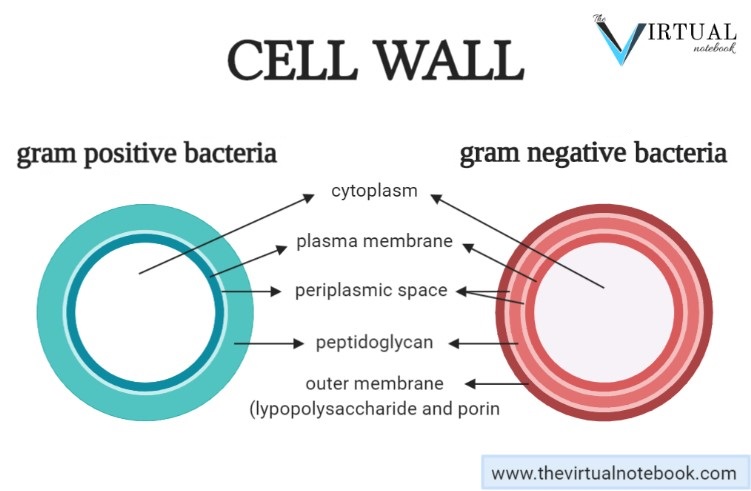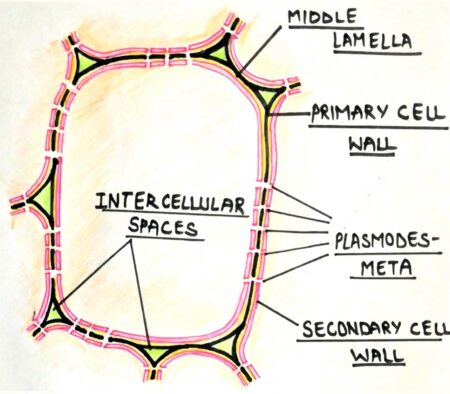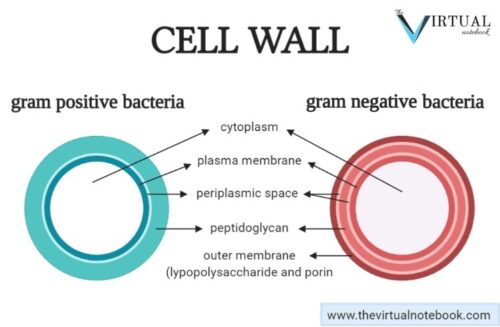Definition for cell wall
The cell wall is the outermost boundary in the majority of prokaryotes and plant cell (eukaryote). It is a structural layer that surrounds some type of cells, present just outside the cell membrane. The prokaryotic cell wall is a semi-rigid, non-living component of the cell that surrounds the plasma membrane. The cell wall is present in prokaryotes (bacteria), fungi and eukaryotes. It is present in only plant cells in eukaryotes. On the other hand, it is absent in the animal cell. Moreover, the presence of the cell wall in plant cells distinguishes them from animal cells.
Robert Hooke observed the cell wall for the first time in the year 1865 in cork cells. Originally it was thought that the cell wall was a non-living secretion of the protoplasm, but now it is known to be metabolically active and is capable of growth.
Cell wall composition
The chemical composition of the cell wall varies in different kingdoms. The cell wall of bacteria comprises peptidoglycan whereas the cell wall of fungi comprises chitin. On the other hand, the plant cell wall is made up of cellulose. Besides cellulose certain other chemicals such as hemicellulose, pectin, lignin, cutin, suberin, silica may also be present on the cell wall.
Peptidoglycan
Peptidoglycan is an alternating linear copolymer of N-acetylglucosamine and N-acetylmuramic acid, linked by glycosidic bonds. Further
Chitin
It is a linear homopolysaccharide comprises of N-acetylglucosamine residues in β1=4 linkage. Its structure is similar to that of cellulose. The only chemical difference is the replacement of the hydroxyl group at C-2 with an acetylated amino group. Like cellulose, it cannot be digested by vertebrates.
Cellulose
Cellulose is a fibrous, water-insoluble, linear and unbranched homopolysaccharide that consists of 10,000 -15,000 D-glucose units. Further, the D-glucose residues are in β1=4 linkage. It is the major component of the primary (20-30% of the dry weight) and secondary (40-90% of the dry weight) wall layers. It provides shape and strength to the cell wall.
Hemicellulose
Firstly, hemicelluloses are matrix polysaccharides. Secondly, they are often branched and hydrophilic heteropolymers, comprises various kinds of monosaccharides such as arabinose, xylose, mannose, galactose, glucose and uronic acid.
Some of the common hemicelluloses go under the names xylans, arabinoxylans, glucomannans, galactomannans and xyloglucans.
It is abundant in the primary walls and is also present in the secondary walls. Moreover, they differ in different species and in different cell types.
Galactose
It is a monosaccharide sugar of the aldose group, derived from lactose. It is a non-cellulosic sugar present in the cell wall.
Xylose
Xylose, a storage polysaccharide, is the major component of the thick storage walls of some seeds. They typically constitute about 20% of the primary cell walls of dicots and 1-5% of the primary walls of grasses. On the other hand ,they appear to be absent from most secondary walls
Mannose
Similarly, it is also a type of storage polysaccharide. In addition, this polysaccharide forms the major hemicellulose of secondary wall of gymnosperm and angiospermous cell.
Arabinose
Arabinose is a monosaccharide containing five carbon atoms. Moreover, this polysaccharide is present in the walls of gymnosperm cells.
Pectic material
It is the major component of the middle lamella but is also present in the primary walls. Pectic acid is the polymer of about 100 galacturonic acid molecules. It is hydrophilic in nature. Secondly, it forms salt bridges with calcium and magnesium ions.
Pectin is heterogeneous and branched polysaccharides. It is a polymer of around 200 D- galacturonic (negatively charged) acid molecules along with D-glucuronic acid residues. It is less hydrated as compared to pectic acid.
Proteins
Different varieties of protein are present in the cell wall, most of which are linked with carbohydrate forming glycoprotein.
Extensins are present in the primary cell walls of dicots making up 1-10% of the wall. They are present in the primary walls of grasses in considerably smaller amounts. Moreover, secondary walls are devoid of extensins.
Arabinogalactan-proteins are another protein component of the cell wall. The protein portion contains a high proportion of hydroxyproline, serine, alanine, and glycine.
Mineral deposits
Mineral substances like silica and calcium carbonate may deposit on cell wall. Silica is commonly noted in the epidermal walls of Equisetum, leaves of grasses etc.
Additional materials are deposited in the secondary cell wall.
- Lignin: Lignin is a biological plastic and non-fibrous material. It occurs only in the mature cell wall. Lignin is deposited in the cells of woody plants. In short, It helps in binding the wood fiber cells and provides strength.
- Cutin: likewise, it is also a biological plastic and wax-like deposit present in the epidermal cells of the exposed surfaces. As a
resu lt, It makes the surface of the cells impermeable to water. - Suberin: It is a fat-like (water-resistant) deposit present in the secondary wall of cork cells. It makes the cell wall impermeable to water.
Cell wall of bacteria
There are two different types of cell wall of bacteria:
- Gram-positive: possesses a thicker cell wall containing many layers of peptidoglycan and teichoic acid.
- Gram-negative: have relatively thinner cell wall with few layers of peptidoglycan surrounded by a second lipid membrane containing lipopolysaccharides and lipoprotein.

Structure
Cell wall of bacteria comprises two heteropolymers, mucopeptide and peptidoglycans (murein). Murein is a complex of disaccharides and polypeptide (NAM &NAG).
Both NAM (N-Acetyl Muramic Acid) and NAG (N-Acetyl Glucosamine) linked alternatively to form carbohydrate backbone like this;
-NAM-NAG-NAM-NAG-
A tetrapeptide chain is attached to NAM. Adjacent tetrapeptide may be directly bound to each other or may be linked by an oligopeptide bridge to form a cross-link between two chains.
The cell wall of plant cell
A typical plant cell has three distinct regions:
- Primary wall (thin and elastic)
- Secondary wall (thick and rigid)
- Middle lamella

Primary wall
The micro fibrils are oriented variously according to shape and thickness of the wall. The matrix of the primary wall is mainly comprises water, hemi-cellulose, pectin and glycoprotein. Pectin is the filling material of the matrix. Hemi-cellulose binds the microfibrils with the matrix and the glycoprotein control the orientation of the microfibrils.
Secondary wall
Secondary wall is very rigid and does not alter its shape. It grows in thickness by the deposition of materials over the existing structures (accretion). It consists of cellulosic chains that bundle together to form micelles or elementary fibrils. Substances like lignin, suberin, minerals, waxes, tannins, resins, gums, inorganic salts such as calcium carbonate, and calcium oxalate, silica etc., may be present in the secondary wall.
The formation of secondary wall is not uniform in all the cells. As a result, various types of cells, such as parenchyma, collenchyma, sclerenchyma, fibres and tracheids will form.
Also, the secondary wall consists of two continuous interpenetrating systems one of which is the cellulose micro fibrils and the other is continuous system of microcapillary spaces. These spaces may contain lignin, cutin, suberin, hemi-cellulose and other organic substances and sometimes even some mineral crystals.
Middle lamella
Middle lamella is present between the two adjacent cell walls. You can say that it is a sandwich between the
Other structures
Other than above mentioned regions, cell wall of plant cell also contain plasmodesmata, various kinds of pits.
Plasmodesmata
The cell wall is not totally complete around the cell. It has narrow pores that carry fine strands of cytoplasm, which interlink the contents of the cells. They are called plasmodesmata. They develop from the close association between plasma membrane and the endoplasmic reticulum. Plasmodesmata serves as a passage for many substances to pass through.
Pits
Pits are relatively thinner portions of the cell wall that adjacent cells can communicate or exchange fluid through. The pits of adjacent cells are opposite to each other. Each pit has a pit chamber, a pit aperture and a pit membrane. Pit chamber is the hollow area where the secondary layers of the cell wall are absent. The pit aperture is the opening at either end of the pit chamber. The pit membrane consists of middle lamella and primary wall. Further, pit membrane has many minute pores and thus they are permeable.
Generally, Pits are of two types:
- Simple: the width of the pit chamber is uniform. In addition, no secondary wall is present.
- Bordered pits: the secondary wall partly overhangs the pit. It contain larger pit chamber and smaller pit aperture.
Cell wall of fungi
Unlike bacterial and plant cells, fungal cells have chitin and chitosan in their cell wall. Many fungi also contain melanin in their cell walls, which contribute to their distinctive colours. Chitin is a polysaccharide similar in structure to cellulose and is also a major component of the exoskeletons of arthropods like insects or crustaceans, and fish scales. Chitin is also responsible for providing most of the structural strength of the fungal cell wall and is responsible for keeping the organism’s shape. Lastly, fungal cell walls tend to contain hydrophobins, hydrophobic amino acids that link together to form a water-repelling coating.
Function of cell wall
- It provides a definite shape and strength to the cell.
- The cell wall protects the internal protoplasm against injury.
- It also prevents the bursting of plant cells due to endosmosis.
- It gives rigidity to the cell.
- The walls of xylem vessels, tracheids and sieve tubes are specialized for long-distance transport.
- In many cases, the cell wall takes part in defence from predators.
Sources of Information
Cell and molecular biology by Prakash S. lohar, MJP Publishers, page no. 16-18
Cell Biology, Genetics, Molecular Biology, Evolution and Ecology by P.S. Verma and V.K. Aggarwal,2005 edition, page no. 146-48
Lehninger; principles of biochemistry by Michael M. Cox and David E. nelson, page no. 246,247, 795-96
